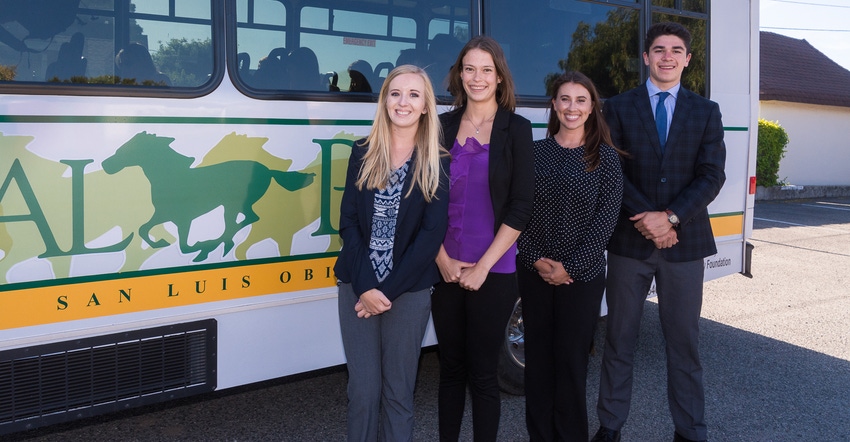June 7, 2018

In a social media world in which no topic is off-limits, perhaps one issue still remains taboo for open discussion: suicide.
Research by four Cal Poly San Luis Obispo agriculture communication students found that suicide rates in agriculture are five times higher than the national average — and shockingly, even double the rate for military veterans. Among the reasons: net farm income worries (the leading cause), social isolation among farmers, pesticide-induced issues, and the ever-present stigma related to mental health issues in this country.
The students — Kaylee Kessler, Vista, Calif.; Kayla Copus, Merced, Calif.; Michael Armstrong, Laguna Niguel, Calif.; and, Alison Ramsey, Sonora, Calif. — recently presented findings from their research to a group of agricultural leaders at the Salinas office of the Grower-Shipper Association of Central California.
Dr. Scott Vernon, Cal Poly professor and course instructor, assigned students various topics to research based on his understanding and knowledge of issues important to agriculture. Kessler says farmer suicide was not her group’s first choice, though she admits being drawn to the topic because she comes from a military community where suicide among veterans is a topic of discussion.
Agricultural leaders in the audience appeared shocked at the statistics shared. “These are pretty daunting statistics,” said one audience member. Armstrong admitted he was “shocked” and “had no idea the problem was this big.”
Other findings from the students’ report suggest:
Suicide rates in agriculture are higher than for any other occupation: 84.5 per 100,000 people, according to the Centers for Disease Control.
Studies suggest suicide rates may be higher as some deaths are reported as accidents rather than suicides.
Not all farm states are included in CDC farm suicide statics (California, Iowa, Illinois, and Nebraska are excluded), further skewing the numbers.
Suicide rates appear to be higher in the Midwest than in California because of the diversified nature of agriculture in California and the greater likelihood of financial profitability among crops grown in the Golden State.
Access to mental health services remain limited to farmers because of the rural nature of their occupations.
Suicide rates are about 50 percent higher today than they were during the farm crisis of the 1980s.
The students agree: Social stigmas and taboos against talking about mental health issues in general, and farmer suicide specifically, must be torn down. “I think the stigma is a symptom of the overall need to discuss it more, and to bring up the fact that farmers are committing suicide,” says Ramsey.
Vernon says the idea behind the class assignments was not for students to conduct their own research, but to do literature reviews of the topics. Students would then present their findings in class. He selected the top three reports to highlight in presentations to the agriculture industry. The goal of the projects was to pick topics that were important to the industry and that could legitimately be addressed by students.
Published information on farmer suicide is limited, the students note. Government statistics do not represent an accurate picture, and even attempts by lawmakers to address the issue through the farm bill are lacking (Congress created a program in the 2008 farm bill to address farmer suicides, then elected not to fund it).
In the 2008 legislation, the Farm and Ranch Stress Assistance Network program would have created a national crisis hotline for farmers, as well as state and regional counseling services. It was modeled after “Sowing Seeds of Hope,” a program that successfully reduced farmer suicide rates in seven Midwestern states until 2014. The federal program in the 2008 legislation would have cost $18 million annually, and was never funded.
“Critics argue that the emotional and economic toll of farmers taking their own lives is greater than the $18 million it would have cost to fund the program,” the students noted in their research paper.
Language was added to current farm bill discussions to create the “Stemming the Tide of Rural Economic Stress and Suicide (STRESS) Act” that could reauthorize previous Farm Bill language and perhaps offer some mental health assistance to farmers. Discussions are ongoing.
In the meantime, the Cal Poly San Luis Obispo students agree that conversations about farmer and rancher mental health issues must begin to bravely broach taboo topics such as suicide and depression.
You May Also Like




